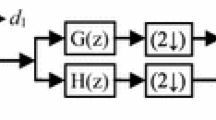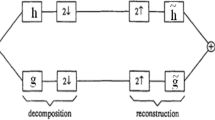Abstract
Wavelets are a powerful tool for signal and image denoising. Most of the denoising applications in different fields were based on the thresholding of the discrete wavelet transform (DWT) coefficients. Nevertheless, DWT transform is not a time or shift invariant transform and results depend on the selected shift. Improvements on the denoising performance can be obtained using the stationary wavelet transform (SWT) (also called shift-invariant or undecimated wavelet transform). Denoising using SWT has previously shown a robust and usually better performance than denoising using DWT but with a higher computational cost. In this paper, wavelet shrinkage schemes are applied for reducing noise in synthetic and experimental non-destructive evaluation ultrasonic A-scans, using DWT and a cycle-spinning implementation of SWT. A new denoising procedure, which we call random partial cycle spinning (RPCS), is presented. It is based on a cycle-spinning over a limited number of shifts that are selected in a random way. Wavelet denoising based on DWT, SWT and RPCS have been applied to the same sets of ultrasonic A-scans and their performances in terms of SNR are compared. In all cases three well known threshold selection rules (Universal, Minimax and Sure), with decomposition level dependent selection, have been used. It is shown that the new procedure provides a good robust denoising performance, without the DWT fluctuating performance, and close to SWT but with a much lower computational cost.









Similar content being viewed by others
References
Galloway, R.L., McDermott, B.A., Thurstone, F.L.: A frequency diversity process for speckle reduction in real-time ultrasonic images. IEEE Trans. Ultrason. Ferroelectr. Freq. Control 35, 45–49 (1988)
Newhouse, V.L., Bilgutay, N.M., Saniie, J., Furgason, E.S.: Flaw-to-grain echo enhancement by split spectrum processing. Ultrasonics 20, 59–68 (1982)
Karpur, P., Canelones, O.J.: Split spectrum processing: a new filtering approach for improved signal-to-noise ratio enhancement of ultrasonic signals. Ultrasonics 30, 351–357 (1992)
Donoho, D.L., Johnstone, I.M.: Ideal spatial adaptation by wavelet shrinkage. Biometrika 81, 425–455 (1994)
Donoho, D.L., Johnstone, I.M., Kerkyacharian, G., Picard, D.: Wavelet shrinkage: asymptotia? J. R Stat. Soc. Ser. B 57, 301–369 (1995)
Donoho, D.L., Johnstone, I.M.: Adapting to unknown smoothness via wavelet shrinkage. J. Am. Stat. Assoc. 90, 1200–1224 (1995)
Johnstone, I.M., Silverman, B.W.: Wavelet threshold estimators for data with correlated noise. J. R Stat. Soc. 59, 319–351 (1997)
Jansen, M.: Noise Reduction by Wavelet Thresholding. Lecture Notes in Statistics 161. Springer, New York (2001). doi:10.1007/978-1-4613-0145-5
Nason, G.P., Silverman, B.W.:The stationary wavelet transform and some statistical applications. In: Antoniadis, A., Oppenheim, G. (eds.) Wavelets and Statistics. Lecture Notes in Statistics, Vol. 103, pp 281–299. Springer, New York (1995)
Lang, M., Guo, H., Odegard, J.E., Burrus, C.S.: Noise reduction using an undecimated discrete wavelet transform. IEEE Signal Proc. Lett. 3, 10–12 (1996)
Coifman, R.R., Donoho, D.L.: Translation-invariant de-noising. In: Antoniadis, A., Oppenheim, G. (eds.) Wavelets and Statistics. Lecture Notes in Statistics, vol. 103, pp 125–150, Springer, New York (1995) .
Abbate, A., Koay, J., Frankel, J., Schroeder, S.C., Das, P.: Signal detection and noise suppression using a wavelet transform signal processor: application to ultrasonic flaw detection. IEEE Trans. Ultrason. Ferroelectr. Freq. Control 44, 14–26 (1997)
Lázaro, J.C., San Emeterio, J.L., Ramos, A., Fernandez, J.L.: Influence of thresholding procedures in ultrasonic grain noise reduction using wavelets. Ultrasonics 40, 263–267 (2002)
Matz, V., Smid, R., Starman, S., Kreidl, M.: Signal-to-noise ratio enhancement based on wavelet filtering in ultrasonic testing. Ultrasonics 49, 752–759 (2009)
Kubinyi, M., Kreibich, O., Neuzil, J., Smid, R.: EMAT noise suppression using information fusion in stationary wavelet packets. IEEE Trans. Ultrason. Ferroelectr. Freq. Control 58, 1027–1036 (2011)
Shi, G.M., Chen, X.Y., Song, X.X., Qui, F., Ding, A.L.: Signal matching wavelet for ultrasonic flaw detection in high background noise. IEEE Trans. Ultrason. Ferroelectr. Freq. Control 58, 776–787 (2011)
Song, S.P., Que, P.W.: Wavelet based noise suppression technique and its application to ultrasonic flaw detection. Ultrasonics 44, 188–193 (2006)
Rodriguez, M.A., San Emeterio, J.L., Lázaro, J.C., Ramos, A.: Ultrasonic flaw detection in NDE of highly scattering materials using wavelet and Wigner-Ville transform processing. Ultrasonics 42, 847–851 (2004)
Zhang, G.M., Zhang, S.Y., Wang, Y.W.: Application of adaptive time-frequency decomposition in ultrasonic NDE of highly-scattering materials. Ultrasonics 38, 961–964 (2000)
Drai, R., Khelil, M., Benchaala, A.: Time frequency and wavelet transform applied to selected problems in ultrasonics NDE. NDT & E Int. 35, 567–572 (2002)
Pardo, E., San Emeterio, J.L.: Noise reduction in ultrasonic NDT using undecimated wavelet transforms. Ultrasonics 44, e1063–e1067 (2006)
Kechida, A., Drai, R., Guessoum, A.: Texture analysis for flaw detection in ultrasonic images. J. Nondestruct. Eval. 31, 108–116 (2012). doi:10.1007/s10921-011-0126-4
Rucka, M., Wilde, K.: Experimental study on ultrasonic monitoring of splitting failure in reinforced concrete. J. Nondestruct. Eval. 32, 372–383 (2013). doi:10.1007/s10921-013-0191-y
Hosseini, S.M.H., Duczek, S., Gabbert, U.: Damage localization in plates using mode conversion characteristics of ultrasonic guided waves. J. Nondestruct. Eval. 33, 152–165 (2014). doi:10.1007/s10921-013-0211-y
Mohammed, M.S., Ki-Seong, K.: Shift-invariant wavelet packet for signal de-noising in ultrasonic testing. Insight 54, 366–370 (2012)
San Emeterio, J.L., Rodriguez-Hernandez, M.A.: Wavelet denoising of ultrasonic A-scans by random partial cycle spinning. In: Proceedings of the 2012 IEEE International Ultrasonics Symposium. pp 455–458.
Mallat, S.G.: A theory of multiresolution signal decomposition: the wavelet representation. IEEE Trans. Pattern Anal. Mach. Intell. 11, 674–693 (1989)
Shensa, M.J.: The discrete wavelet transform: wedding the à trous and Mallat algorithms. IEEE Trans. Signal Process. 40, 2464–2482 (1992). doi:10.1109/78.157290
Beylkin, G., Coifman, R., Rokhlin, V.: Fast wavelet transforms and numerical algorithms. Commun. Pure Appl. Math. 44, 141–183 (1991)
Daubechies, I.: Ten Lectures on Wavelets. SIAM, Philadelphia (1992)
Romijn, R.L., Thijssen, J.M., Vanbeuningen, G.W.J.: Estimation of scatterer size from backscattered ultrasound: a simulation study. IEEE Trans. Ultrason. Ferroelectr. Freq. Control 36, 593–606 (1989)
Gustafsson, M.G., Stepinski, T.: Studies of split spectrum processing, optimal detection, and maximum likehood amplitude estimation using a simple clutter model. Ultrasonics 35, 31–53 (1997)
Acknowledgments
This work was partially supported by Spanish MCI Project DPI2011-22438
Author information
Authors and Affiliations
Corresponding author
Rights and permissions
About this article
Cite this article
San Emeterio, J.L., Rodriguez-Hernandez, M.A. Wavelet Cycle Spinning Denoising of NDE Ultrasonic Signals Using a Random Selection of Shifts. J Nondestruct Eval 34, 270 (2015). https://doi.org/10.1007/s10921-014-0270-8
Received:
Accepted:
Published:
DOI: https://doi.org/10.1007/s10921-014-0270-8




